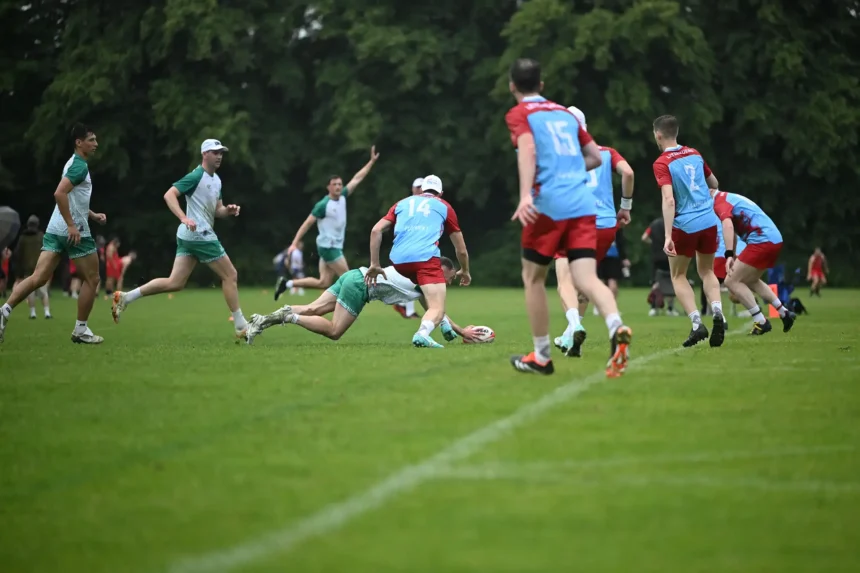Introduction
Touch rugby is an exciting, non-contact version of rugby that has gained popularity worldwide. It’s a game that requires speed, skill, and quick thinking, making it perfect for players of all ages and fitness levels. Whether you’re a beginner just starting out or someone who’s been introduced to the sport recently, understanding the core touch rugby rules is the first step toward enjoying the game fully.
Unlike traditional rugby, which is focused on physical tackles and scrums, touch rugby promotes a fun, inclusive environment by eliminating hard tackles and emphasizing agility, ball handling, and teamwork. Its simplicity makes it easy for new players to pick up, but its strategic depth allows seasoned players to continue refining their skills.
Touch Rugby Rules and Regulations
The Basics of Touch Rugby
Touch rugby is typically played with two teams, each consisting of six players. The primary objective is to score more tries (the equivalent of a touchdown in American football) than the opposing team within a set period. A try is scored when the ball is placed down in the opponent’s try zone, which is similar to the end zone in American football. However, the key difference in touch rugby is that players do not tackle one another. Instead, they stop a player’s progress by making a light “touch.”
When a player is touched, the play immediately stops, and the ball carrier must perform a “play-the-ball,” a key touch rugby concept. The attacking team then has the opportunity to pass or run the ball to advance toward the try line.
Unlike traditional rugby, where the game is stopped by a tackle, touch rugby is faster-paced, and the emphasis is on passing and maintaining possession. The game encourages skillful running, passing, and positioning, which makes it both physically demanding and mentally engaging.
How the Game is Played
The match begins with a tap-off, similar to a kick-off in rugby, where the ball is tapped from the center of the field by one team to get the game started. From here, both teams take turns attacking and defending, trying to outmaneuver the opposition.
The team in possession of the ball attempts to make forward progress by passing the ball backwards (no forward passes are allowed), while the defending team tries to stop them by making a touch. After each touch, the player who was touched must place the ball on the ground and tap it with their foot before passing it to a teammate.
The attacking team has a set number of touches (usually six) before they must hand the ball over to the other team, similar to the turnover system in rugby league. However, during these touches, players can pass, run, and use their skills to break through the defense, aiming to score a try.
Key Touch Rugby Rules
While touch rugby might seem like a simple game, there are several key rules and regulations that govern how the game is played. These rules ensure that the game flows smoothly and that all players, regardless of their experience level, are on equal footing. Some of the most important touch rugby rules include:
The Touch
A “touch” is considered a successful defensive action, where a player from the defending team lightly contacts the ball carrier. The player who has been touched must immediately stop, and the ball must be played within a set time limit, usually 6 seconds. If the ball carrier fails to play the ball within the allotted time, the team loses possession.
The Play-the-Ball
After a touch, the player who has been touched must perform a “play-the-ball.” This means they must place the ball on the ground, tap it with their foot, and then pass it to a teammate. The play-the-ball action is critical to ensuring that the game remains fast-paced and continuous.
Scoring a Try
A try is scored when a player touches the ball down in the opponent’s try zone, which is located at the end of the field. Unlike traditional rugby, there is no need for a conversion kick after a try, so once the ball is touched down in the try zone, the attacking team has successfully scored.
Substitutions
In touch rugby, there are usually no set timeouts, but teams are allowed to make substitutions during the game. Players can be substituted in and out, allowing teams to maintain a high level of intensity and avoid fatigue. The player coming off the field must be completely off before a new player enters the game.
Summing Up
Touch rugby is an exciting, dynamic, and non-contact version of rugby that focuses on speed, skill, and teamwork. For beginners, understanding the basic touch rugby rules is crucial to getting started and enjoying the game. Whether you’re looking to join a casual game with friends or are interested in competitive play, knowing the rules and regulations will help you play effectively and confidently.
From the key concepts of the “touch” and “play-the-ball” to more advanced rules like offside and substitutions, touch rugby offers an excellent balance of fun and strategy. The more you practice, the better you’ll understand the nuances of the game, but starting with the basics will set you on the path to success.
Remember that touch rugby is a fast-paced game that encourages skillful ball handling, quick thinking, and teamwork. While there are a few mistakes to avoid, practice and communication with your teammates are essential to becoming a strong player.


